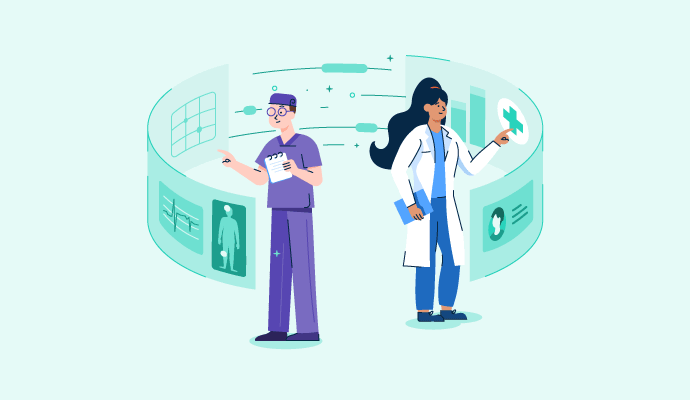April 18, 2024
 by Alyssa Towns / April 18, 2024
by Alyssa Towns / April 18, 2024

You get the flu and head to a nearby urgent care as your fever skyrockets. When you arrive at urgent care, the healthcare provider at the front desk quickly accesses your medical history to check you in. During the appointment, a doctor pulls up your medication records to confirm the prescribed treatment for the flu won’t cause any adverse reactions to existing medications.
The doctor recommends a follow-up visit with your primary care physician in two weeks and shares the details of your urgent care visit with them. And when you get home, you can access your treatment and appointment information online via a patient portal.
Interoperability in healthcare has the potential to make the imagined scenario common practice.
Interoperability in healthcare refers to an infrastructure that facilitates the exchange of electronic health data in a timely, secure, integrated manner in efforts to optimize healthcare services and provide the best patient outcome. When interoperability is achieved, medical providers can pass medical data and information back and forth across networks without delay.
Electronic health records (EHR) software allows medical providers across various healthcare organizations to access, input, and adjust patient data in real time. Digital files make it easier for medical providers to share information and give patients access to online portals, which increases visibility into their medical records.
Interoperability in healthcare is critical. It’s not uncommon for patients to request and receive care from multiple medical providers at various healthcare organizations. Seamless data transfer becomes even more crucial in situations when a patient needs treatment quickly, but can’t communicate sufficiently, like with a heart attack or anaphylaxis.
Ultimately, interoperability in healthcare improves treatment plans and patient care by providing the right people with the right information when it’s needed the most.
The Office of the National Coordinator for Health Information Technology (ONC), the group responsible for coordinating interoperability nationwide, reported that in 2021, more than 6 in 10 hospitals shared health information electronically, up 51% since 2017. This further indicates its importance and relevance for healthcare facilities and patients alike.
The Healthcare Information and Management Systems Society (HIMSS) is an organization that offers tools and resources for the advancement of interoperability for meaningful health information exchanges. As part of its work, HIMSS created the following four-level pyramid to describe how interoperability works.
.png?width=600&height=338&name=The%20Four%20Levels%20of%20Interoperability%20(1).png)
Foundational interoperability provides the necessary building blocks for effective information exchange. At this level, professionals establish systems to send and receive data. Interconnectivity is implemented and data is available, but that doesn’t mean the system or user will interpret the data correctly or meaningfully.
The structural level serves as a middle layer that takes care of the format, syntax, and data organization for the exchange. Structural interoperability defines the interpretation of data to make certain the meaning of the data goes unaltered as healthcare providers exchange it with one another.
Semantic interoperability creates a shared understanding of the data through codification and standardized definitions. This leads to a meaningful exchange of data that maintains its meaning and integrity. For example, common vocabulary enhances communication between systems, regardless of whether healthcare organizations use different EHR systems.
Organizational interoperability is the highest tier of the pyramid. Here, healthcare organizations share data across different systems and settings and have policies, governance structures, and workflows to support exchanges and communications. This level furthers the goal of seamless information transfers and guarantees that relevant information is accessible to all stakeholders when they need it.
Interoperability protects the continuity of care from one medical provider to another, but it also provides numerous other benefits for everyone involved.
EHR software allows health organizations and medical professionals to access, input, and adjust patient data in real time and provide patient access through online portals. When medical professionals use EHRs, they give more effective care and treatment plan options based on each patient’s medical history.
To qualify for inclusion in the electronic health record category, a product must:
* Below are the top five leading EHR software platforms from G2’s Spring 2024 Grid® Report. Some reviews may be edited for clarity.
ModMed’s flagship product, EMA® – an electronic medical assistant – is a cloud-based system that learns healthcare workers’ practice styles, remembers their preferences, and suggests exam notes and billing codes to save time. Its goal is to support clinical, operational, and financial procedures so clinicians can focus on offering the best care.
“ModMed is a one-stop shop. It has great features, and the creators have thought of everything. A few of the great features include auto-posting of electronic remittance advice (ERAs), ModMed Pay integration, Path and Lab module, analytics, etc. ModMed is very user-friendly as well!”
- ModMed Review, Kasie P.
“Sometimes the updates don't work properly before being released to users. I feel like ModMed's ticket area could use help. I usually don't get proper ticket closure to ensure the issue was reconciled. I usually get a response from client services, but then I never know when the issue is fixed.”
- ModMed Review, Mandi N.
Epic develops proprietary electronic medical record (EMR) software to help people get well and stay well, now and in the future. Epic provides features that expedite patient care, like registration and scheduling functionality, robust clinical systems for managing operations, and billing systems for insurers.
“Epic is a comprehensive record that is relatively easy to navigate (considering the volume of complex information it stores). The interface with other platforms, like Tableau, CipherHealth, and CarePort, is good. Also, creating customized reports to gather data or identify a specific patient population is good.”
- Epic Review, Danielle J.
“Epic has a lot of functions, gadgets, and tools – it feels overwhelming. Despite being trained multiple times by Epic specialists, I still do not know how to use many of these functions. Additionally, there is no good way to filter keywords, so you must go through excess information and waste time. It is definitely not an easy EMR to use because there are a lot of details that are easy to miss and overlook.”
- Epic Review, Selina I.
Carepatron is an all-in-one healthcare system designed for easy scheduling, optimal note-taking and documentation, secure billing, client portal access, and organized health record management. Carepatron serves physical therapists, coaches, mental health professionals, general practice providers, and speech therapists. It also uses medical transcription software artificial intelligence (AI) to improve the accuracy of clinical records and documentation.
“It is easy to navigate, create notes, and track clients. I currently don't bill through it and only see clients in person. I like how it's also pretty easy to reach out if I need help, and that I can easily customize and create templates that work for me for different types of notes. It's much more affordable than other platforms and I feel it offers just as much as more expensive platforms. It's also pretty easy to navigate through and takes a short time to get acclimated to it.”
- Carepatron Review, Jessie L.
“The simplicity of the system brings limitations, such as the inability to customize small things, like only showing initials on the calendar to protect confidentiality.”
- Carepatron Review, Monika D.
eClinicalWorks (eCW) is a comprehensive and secure solution designed to give healthcare workers access to their data at all times. It automates administrative tasks, speeds up billing processes, and offers patient engagement tools.
“After using other electronic health record programs, I find eClinicalWorks to be a dream. The ease of documenting different information is amazing, from medical information to general visitation notes. It's easy to navigate and super easy to learn.”
- eClinicalWorks Review, Shawna D.
“ One of the latest updates I had while using eCW was probably my least favorite part about this software. If you were inside the patient chart and making changes, nobody else was allowed to make changes simultaneously. This is something significant that I think should be reconsidered. At least enable real-time edits so everyone with access to the patient chart can view it. Otherwise, it almost feels like it defeats the purpose of an electronic health record, where it should be saving time. Instead, it can take just as long as a written chart.”
- eClinicalWorks Review, Zane A.
SimplePractice is an EHR software tool for health and wellness providers. They use it to pare down admin tasks, automate insurance claims and coverage reports, and grow their practices. SimplePractice includes scheduling, documentation, billing, and client communication functionality to give private practice partners everything they need to manage their business and provide quality client care.
“I love that SimplePractice has everything in one platform. It saves me a lot of time. I don't have to worry about clients getting appointment reminders. I also love that the system can load preview notes. I save a lot of time writing my notes. I love being able to create my own documents. I love that I can add homework to my clients using the portal. I love that I have also gotten referrals with the Monarch directory. Their customer support was also beneficial and solved my issue extremely fast.”
- SimplePractice Review, Alejandra S.
“I wish the calendar syncing feature was included in the lower level plans. The cost of the highest level does not make sense for my practice and this feature would really be helpful, but not worth the cost.”
- SimplePractice Review, Paige F.
Interoperability in healthcare only leads to better outcomes for medical providers, patients, and communities. Healthcare organizations can implement an interoperability strategy, starting at the foundational level and working toward full interoperability for the best results.
Are you on a mission to improve patient outcomes? Healthcare business intelligence empowers organizations to use medical data to identify trends, extract insights, and optimize operations to ensure all patients receive quality care.
Alyssa Towns works in communications and change management and is a freelance writer for G2. She mainly writes SaaS, productivity, and career-adjacent content. In her spare time, Alyssa is either enjoying a new restaurant with her husband, playing with her Bengal cats Yeti and Yowie, adventuring outdoors, or reading a book from her TBR list.
Picture this: a bustling hospital. Numerous doctors, nurses, and staff busy with different...
 by Remy Church
by Remy Church
Technology has transformed every industry, and its impact on the healthcare sector is...
 by Dan Hall
by Dan Hall
Telehealth is an evolving industry within healthcare, influenced by developments in technology...
 by Katherine Ellison
by Katherine Ellison
Picture this: a bustling hospital. Numerous doctors, nurses, and staff busy with different...
 by Remy Church
by Remy Church
Technology has transformed every industry, and its impact on the healthcare sector is...
 by Dan Hall
by Dan Hall


